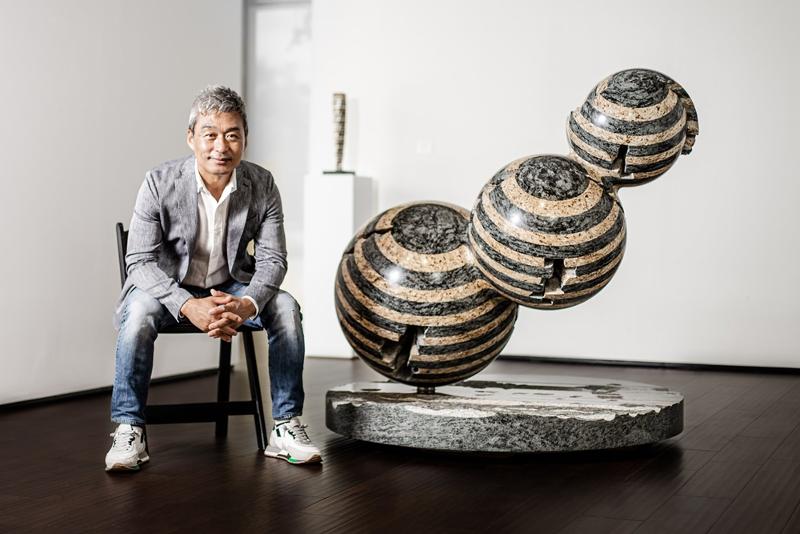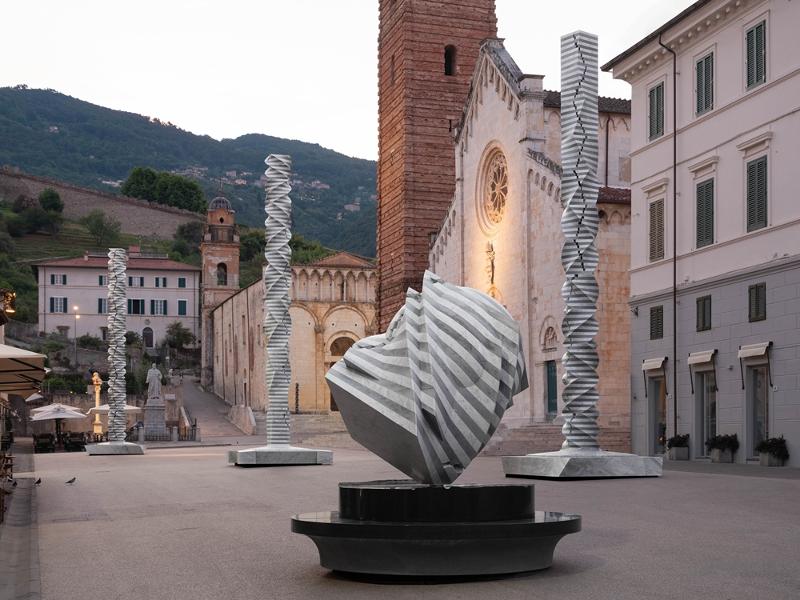
Sculptor Park Eun Sun. (Art of the World Gallery)
By Gil Kyuyoung
Pietrasanta is a small city with a population of about 25,000 in Tuscany, Italy. An 11-meter-tall marble pillar stands in the middle of the serene Piazza Duomo (Cathedral Square). It is reminiscent of an obelisk from ancient Egypt. Two colors intersect each other on top of the geometric pillar, and on top of that is a crack. It might be due to a crevice on the smooth surface, but it is hard to feel the gravity of the pillar despite its weight of 20 tons. Rather than overwhelming the surrounding landscape, the pillar naturally forms a harmony with it and infuses vivacity into the quiet plaza.
The pillar "Colonna Infinita” (Infinite Column) was created by Korean artist Park Eun Sun, who is working as a sculptor in Italy. The exhibition was held by Pietrasanta and the Contini Art Gallery to commemorate the 30th anniversary of his works.
Park received the Fratelli Rosselli Award in 2018, which is given to some of the best sculptors working in Italy. He was named an honorary citizen of Pietrasanta in 2021 and is called a "maestro."
Park had dreamed of becoming a painter since he was little, but majored in sculpture at Kyung Hee University before moving to Italy in 1993 with his wife, a decision he made to break away from the burden of reality and focus solely on his artwork. It is now 30 years since he settled in Pietrasanta, home to his sculptures.
He is now an artist who has gained recognition not only in Italy but around the world. He still spends most of his time in his studio. Park’s diligence is as sturdy as the marble he works in.
An art museum called "Atelier Park Eun Sun" is slated to open in Pietrasanta in the second half of this year. Mario Botta, a globally renowned Swiss architect who designed Kyobo Tower and Leeum Museum of Art in Seoul, is in charge of the museum's design.
An art studio that was made by renovating a former glass factory will be turned into an office and an exhibition hall.
When asked about his thoughts, Park said, "Not much will change after opening the museum."
"I will continue to steadily make sculptures like I always have." His calm words reflected his long-built skills and experience from decades of sculpting.
Below is Korea.net's written interview with Park on July 21:

"Colonna Infinita – Accrescimento” (Infinite Column – Growth) installed in the Piazza Duomo (Cathedral Square) in Pietrasanta, Italy. The exhibition will be held until Sept. 22. (Park Eun Sun's official website)
- What led you to become an artist?
I have dreamed of becoming an artist since I was little. I had big ambitions of becoming a sculptor when I started college as a sculpture major at Kyung Hee University. However, I had to constantly shift to part-time jobs as my family started to face financial difficulties. I thought I would regret it if I continued to live like that. I thought of how I could focus solely on sculpting, and that was why I moved to Pietrasanta, Italy.
- What do Italy, and in particular, Pietrasanta, mean to you?
When I first arrived in Italy, I struggled with language barriers, financial difficulties, and racial discrimination. I held on solely through my passion for sculpture and focused on sculpting all day long. Then, there emerged some people who acknowledged my work. Pietrasanta is a place that has created many stories in my life, which were full of vicissitudes. For me, Pietrasanta is my second home.
- How does your identity as a Korean affect your work?
Just like any other artist, I also went through a time when I wandered to find my identity. I gradually lost confidence as a foreign national living abroad. But at some point, everything felt meaningless.
I wondered why I had to worry when I was born in Korea, first learned how to walk as a toddler, went through elementary, middle and high school and a college there. I decided to embrace my identity as a Korean to work on sculpting, and it was then that Europeans at last opened up to my art. They empathized with the natural and true aspects of my work.
- When did you feel pride as a Korean in Italy?
Until the 1990s, most people did not know where Korea was. Nowadays, I feel that Korea's standing has changed in Italy due to K-pop and Korean TV dramas. However, Korea is still quite unknown in the field of contemporary art. With a sense of duty as a Korean artist, I want to lead in promoting Korean contemporary art from now on.
- What is the cultural difference between Korea and Italy?
Italy was the center of Western culture in the past. Throughout its long history, Italy's distinctive color and culture have naturally taken place. As a result, the country boasts excellent artistic taste in various fields such as art, design, and fashion. On the other hand, Korea is an ever-changing country. It has infinite potential to expand ahead. It is like a piece of jade hidden within a deep place.
- What is your goal or vision that you wish to achieve by opening an art museum?
Not much will change after opening the museum. I will continue to steadily make sculptures like I always have. However, the museum will become an impetus for me that adds to my sense of responsibility and duty as an artist.
- What are your plans and your goals or dream?
Numerous exhibitions around the world await me. I want to become sturdier as an artist. I want to work with joy, as I endlessly empty and fill up.
- Last but not least, what do you wish to say to Korea.net readers?
Become true to yourself. I always talk with myself. I take out all my thoughts and mind without filtering them out. I endlessly ask myself what am I doing now and why, and seek answers. Above all, an artist must be honest. Honesty is a courtesy toward the spectator.
gilkyuyoung@korea.kr